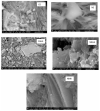An Elucidative Review of the Nanomaterial Effect on the Durability and Calcium-Silicate-Hydrate (C-S-H) Gel Development of Concrete
- PMID: 37623068
- PMCID: PMC10453857
- DOI: 10.3390/gels9080613
An Elucidative Review of the Nanomaterial Effect on the Durability and Calcium-Silicate-Hydrate (C-S-H) Gel Development of Concrete
Abstract
Concrete as a building material is susceptible to degradation by environmental threats such as thermal diffusion, acid and sulphate infiltration, and chloride penetration. Hence, the inclusion of nanomaterials in concrete has a positive effect in terms of promoting its mechanical strength and durability performance, as well as resulting in energy savings due to reduced cement consumption in concrete production. This review article discussed the novel advances in research regarding C-S-H gel promotion and concrete durability improvement using nanomaterials. Basically, this review deals with topics relevant to the influence of nanomaterials on concrete's resistance to heat, acid, sulphate, chlorides, and wear deterioration, as well as the impact on concrete microstructure and chemical bonding. The significance of this review is a critical discussion on the cementation mechanism of nanoparticles in enhancing durability properties owing to their nanofiller effect, pozzolanic reactivity, and nucleation effect. The utilization of nanoparticles enhanced the hydrolysis of cement, leading to a rise in the production of C-S-H gel. Consequently, this improvement in concrete microstructure led to a reduction in the number of capillary pores and pore connectivity, thereby improving the concrete's water resistance. Microstructural and chemical evidence obtained using SEM and XRD indicated that nanomaterials facilitated the formation of cement gel either by reacting pozzolanically with portlandite to generate more C-S-H gel or by functioning as nucleation sites. Due to an increased rate of C-S-H gel formation, concrete enhanced with nanoparticles exhibited greater durability against heat damage, external attack by acids and sulphates, chloride diffusion, and surface abrasion. The durability improvement following nanomaterial incorporation into concrete can be summarised as enhanced residual mechanical strength, reduced concrete mass loss, reduced diffusion coefficients for thermal and chloride, improved performance against sulphates and acid attack, and increased surface resistance to abrasion.
Keywords: C-S-H gel; concrete; durability; energy savings; nanomaterial.
Conflict of interest statement
The authors declare no conflict of interest.
Figures




















References
-
- Nazeer M., Kapoor K., Singh S.P. Strength, durability and microstructural investigations on pervious concrete made with fly ash and silica fume as supplementary cementitious materials. J. Build. Eng. 2023;69:106275. doi: 10.1016/j.jobe.2023.106275. - DOI
-
- Mehta P.K., Monteiro P.J.M. Durability in Concrete: Microstructure, Properties, and Materials. McGraw-Hill Companies, Inc.; New York, NY, USA: 2005. pp. 121–199.
-
- Al-Jabari M. Integral Waterproofing of Concrete Structures. Woodhead Publishing; Cambridge, UK: 2022. Concrete durability problems: Physicochemical and transport mechanisms; pp. 69–107. Woodhead Publishing Series in Civil and Structural Engineering. - DOI
-
- Li X., Xu Q., Chen S. An experimental and numerical study on water permeability of concrete. Constr. Build. Mater. 2016;105:503–510. doi: 10.1016/j.conbuildmat.2015.12.184. - DOI
-
- Cyr M. Eco-Efficient Concrete. Woodhead Publishing; Cambridge, UK: 2016. Influence of supplementary cementitious materials (SCMs) on concrete durability; pp. 153–197. - DOI
Publication types
Grants and funding
LinkOut - more resources
Full Text Sources

